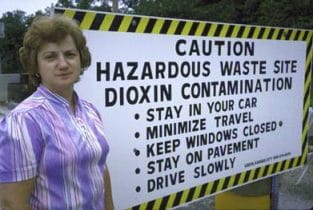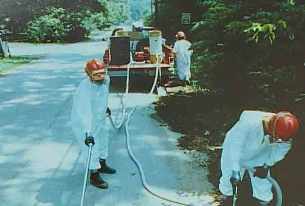
by Ed Mattson
Going back to the long history of Agent Orange and its chief component, 2,4-dichlorophenoxyacetic acid (2,4-D), Wednesday I wrote about the original studies of AO by Professor E.J. Kraus, chairman of the school’s botany department, at the University of Chicago during World War II. Among the discoveries he made was that certain broadleaf vegetation could be killed by causing the plants to experience sudden, uncontrolled growth (much in the way cancer tumor growth works in the body).
Though Agent Orange was not adopted by the Department of the Army for use in WWII, it was eventually added to the arsenal in the late 1950’s and used in Vietnam beginning on January 13, 1962, as part of Operation Hades to eliminate foliage that concealed enemy movement and food supplies. Agent Orange was not the only defoliant used however, and the combination of chemicals became known as “The Rainbow Herbicides” including Agent Blue, White, and Purple. Agent Blue added arsenic to the cocktail while White and Purple included other, just as deadly combinations of chemicals. Remarkably, in spite of knowing how deadly these agents were, little training went into the storage, mixing, and handling of these products, and that is where the criminality of anyone making the case against Agent Orange and these toxins should begin.
According to theSampley Report, “Operation Hades (later called Operation Ranch Hand), the defoliation of portions of South Vietnam’s heavily forested countryside in which Viet Cong guerrillas could easily hide, began in earnest out of Tan Sun Nhut airfield. By September, 1962, the spraying program had intensified, despite an early lack of success, as U.S. officials targeted the Ca Mau Peninsula, a scene of heavy communist activity. Ranch Hand aircraft sprayed more than 9,000 acres of mangrove forests there, defoliating approximately 95 percent of the targeted area. That mission was deemed a success and full approval was given for continuation of Operation Ranch Hand as the U.S. stepped up its involvement in Vietnam”.
An estimated 12 million gallons of Agent Orange were sprayed over all areas of vegetation in Vietnam. The military claimed that the physical impact of humans would have little adverse effects. After all, these same herbicides were being used in the United States. In the US however, the commercial use was heavily diluted with water or oil, and mixed in proper concentrations. It is also obvious that more training in the handling of these agents occurred in the US, because in Vietnam, with the constant turnover of personnel, the military allowed applications of six to 25 times the dilution formula suggested by the manufacturer.
Again, according to the Sampley Report, “The pilots who flew these missions became so proficient at their jobs that it would take only a few minutes after reaching their target areas to dump their 1,000-gallon loads before turning for home. Flying over portions of South Vietnam, Laos and Cambodia that had been sprayed, the pilots could see the effects of their work. Many of them adopted a grim fatalism about the job. Over the door of the ready room for Ranch Hand pilots at Tan Son Nhut Airport near Saigon hung this sign: ‘Only You Can Prevent Forests’.”
It is apparent the conduct of the US government along manufacturers of these chemicals shows willful disregard for the soldier in the field and the citizens of the countries where defoliation occurred (Vietnam, Cambodia, and Laos). It was no secret to the government or the manufacturers that the toxicity to humans was well known, yet little if any cautions regarding herbicides were ever disclosed to those assigned to transport, mix, store, or deploy them over the countryside, thus appearing to be criminal neglect. The chemical companies even went to the extent to cover-up the potential harmful effects of dioxin by publically stating that dioxin occurred naturally in the environment and was not harmful to humans.
A review of the documents related to the use of Agent Orange from decades-old declassified papers from the companies that manufactured it and the government and military that used it, provides compelling evidence that those in charge also concealed evidence of the devastating effects it could have on people. Further review of documents from declassified files, both the government and the chemical companies knew the human health toll it could take.

Additionally, from a declassified letter by V.K. Rowe (Dow’s Biochemical Research Library) to Bioproducts Manager Ross Milholland dated June 24, 1965, he states that Dow knew the dioxin could hurt people when he referenced that, “2,4,5,-trichlorophenol and 2,3,7,8, -tetrachlorodibenzodioxin (components of Agent Orange) is exceptionally toxic and it has a tremendous potential for producing chloracne and systemic injury.” This damning letter by Mr. Rowe showed that the company would suffer if word got out and went on the state, “The whole 2,4,5-T industry would be hard hit and I would expect restrictive legislation, either barring the material or putting very rigid controls upon it would occur.”
The letter closed by saying, “There is no reason why we cannot get this problem under strict control and thereby hopefully avoid restrictive legislation … I trust you will be very judicious in your use of this information. It could be quite embarrassing if it were misinterpreted or misused. Under no circumstances may this letter be reproduced, shown, or sent to anyone outside of Dow.”
There have been many cases brought to court to gain accountability for our veterans and others who have toxin related illness from Agent Orange and the other Rainbow herbicides. Each court case reveals a little more of the puzzle, but I guess we just haven’t found attorneys smart enough to tie it all together. For those of us veterans and civilians (in Vietnam, Cambodia, Laos, Canada, Korea, and elsewhere) the evidence is more than circumstantial or prima facia and to most of us at least, has become conclusive beyond reasonable doubt.
Yet, the chemical companies, with the full support of the VA and our government, continue to contend that “there is no . . . evidence that Agent Orange was hazardous to human health” despite NAS/IOM (National Academy of Science and Institute of Medicine) which found that numerous cancers have been related to exposure to dioxin-contaminated 2,4,5-T (ingredient in Agent Orange) exposure to dioxin-contaminated 2,4,5-T (ingredient in Agent Orange) and stated that the companies had misrepresented the health effects with “patently false” assertions that none of their workers had gotten sick from dioxin poisoning.
Carrying the argument one last step is the government’s reaction to the dioxin incident in Times Beach, Missouri, a once quite little community of about 2,800 residents in eastern Missouri about 20 miles southwest of St. Louis. It was a great place to live and raise children, with plenty of open spaces, two story wood frame houses, quiet streets and none of the pollution, poverty or crime of the inner city.
For several years in the mid 1970s, dioxin laced oil had been sprayed on the town’s roads to keep down the dust. Times Beach was one of 28 eastern Missouri communities where the spraying had been done. But none of the others had the levels of dioxin contamination of Times Beach, parts of which had dioxin levels of 33,000 parts per billion, or 33,000 times more toxic than the EPA’s level of acceptance. The contamination was so bad that the government decided the only way to save the town’s residents from further damage from dioxin was to buy up all the property and move everyone out.
In early 1983, the U.S. government spent $33 million buying the 801 homes and businesses in Times Beach and relocated all the residents. The entire town was fenced in and guards were brought in to keep out the curious. “Caution, Hazardous Waste Site, Dioxin Contamination,” read the signs leading into Times Beach. Today Times Beach is but a ghost town.
So, while the government was paying off the residents of Times Beach because of dioxin contamination that didn’t even reach the levels of exposure that was used in Vietnam and other Southeast Asian countries, it continues to deny veterans who’ve been exposed to Agent Orange and continues to stand-by the notion that as a veteran, YOU must prove beyond reasonable doubt, that Agent Orange is the cause of your health problems.
This is unacceptable behavior for any government and why we citizens must demand that carrying for all those exposed to the herbicide toxins (veterans, USO personnel, and civilian contractors) be cared for as a contractual obligation for service to their country.

Following his service in the Marine Corps Ed Mattson built a diverse career in business in both sales/marketing and management. He is a medical research specialist and published author. His latest book is Down on Main Street: Searching for American Exceptionalism
Ed is currently Development Director of the National Guard Bureau of International Affairs-State Partnership Program, Fundraising Coordinator for the Warrior2Citizen Project, and Managing Partner of Center-Point Consultants in North Carolina.
Mr. Mattson is a noted speaker and has addressed more than 3000 audiences in 42 states and 5 foreign countries. He has been awarded the Order of the Sword by American Cancer Society, is a Rotarian Paul Harris Fellow and appeared on more than 15 radio and television talk-shows.
ATTENTION READERS
We See The World From All Sides and Want YOU To Be Fully InformedIn fact, intentional disinformation is a disgraceful scourge in media today. So to assuage any possible errant incorrect information posted herein, we strongly encourage you to seek corroboration from other non-VT sources before forming an educated opinion.
About VT - Policies & Disclosures - Comment Policy



